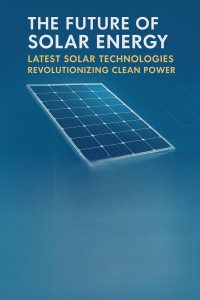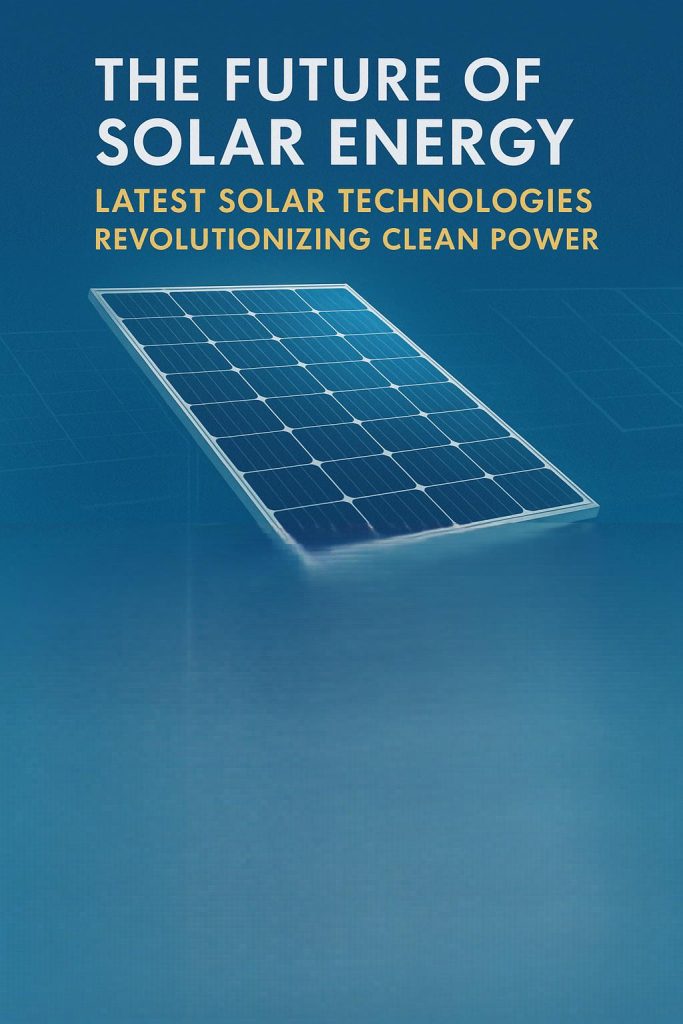Introduction
Solar power continues to evolve at a remarkable pace, with breakthrough innovations reshaping the industry. From advanced photovoltaic cells to smart energy storage systems, the latest solar technologies are enhancing efficiency, durability, and affordability. With the global shift toward renewable energy, these advancements are set to make solar power more accessible and widespread than ever.
In this article, we’ll explore the most cutting-edge solar technologies revolutionizing clean energy, including new solar panel materials, improved efficiency techniques, and emerging trends in solar storage and applications.
1. Next-Generation Solar Panel Technologies
N-Type Solar Cells
Traditional solar panels use P-type silicon, but N-type solar cells have gained popularity due to their higher efficiency and longer lifespan. These panels reduce energy loss and degradation over time, offering better performance for residential and commercial installations.
Heterojunction (HJT) Solar Cells
HJT technology combines crystalline silicon with thin layers of amorphous silicon, improving overall efficiency while maintaining excellent temperature stability. This makes HJT panels ideal for regions with high temperatures, where conventional solar cells may struggle.
TOPcon Technology
TOPcon (Tunnel Oxide Passivated Contact) is another high-efficiency solar cell technology, reducing resistance and increasing power output. Longi and JinkoSolar have been developing TOPcon-based panels to push solar efficiency beyond 24%.
Bifacial Solar Panels
Unlike traditional solar panels, bifacial modules can absorb sunlight from both sides, increasing power generation. They’re particularly effective in areas with reflective surfaces, such as sandy terrain or snowy landscapes.
Perovskite Solar Cells
Perovskite solar cells are one of the most promising emerging technologies, offering higher efficiency and lower production costs compared to conventional silicon-based cells. Scientists are working on stable and scalable perovskite solutions, which could revolutionize solar panel manufacturing in the near future.
2. Solar Energy Storage Innovations
Next-Generation Lithium Batteries
Battery storage plays a crucial role in maximizing solar power usage. New high-density lithium batteries, like Tesla’s Powerwall 3 and BYD’s Blade Battery, offer improved storage capacity, faster charging cycles, and longer lifespans for homes and businesses.
Solid-State Batteries
Solid-state batteries are emerging as game-changers in energy storage, replacing liquid electrolytes with solid materials for safer and more efficient performance. With higher energy densities and longer durability, solid-state batteries could revolutionize solar energy storage solutions.
Hydrogen-Based Solar Storage
Innovators are exploring hydrogen-based storage systems, where excess solar energy is converted into green hydrogen for later use. This method allows long-term solar energy storage without relying on conventional lithium-ion technology.
3. Smart Solar Technology & AI Integration
AI-Enhanced Solar Monitoring
Artificial intelligence is revolutionizing solar installations by improving predictive maintenance, optimizing power output, and enhancing grid integration. AI-driven platforms can analyze real-time data to detect system failures, improve panel efficiency, and adjust power distribution dynamically.
Solar-Powered Internet of Things (IoT) Devices
Innovations in solar-powered IoT devices are increasing energy efficiency across multiple industries. Smart solar lighting, autonomous vehicles, and remote weather monitoring systems now use AI and IoT-powered solar modules for improved functionality.
Floating Solar Farms (Floatovoltaics)
With land scarcity becoming a concern, floating solar farms offer a viable solution by using water surfaces to generate clean energy. Countries like China, India, and the Netherlands are investing heavily in floating photovoltaic (FPV) technology, reducing land costs and increasing energy generation.
4. Solar Applications Beyond Power Generation
Solar Windows & Transparent Panels
Developments in solar windows and transparent solar panels allow buildings to generate electricity from their own glass surfaces. Researchers are integrating see-through solar cells into modern skyscrapers and residential windows for discreet energy production.
Solar Roads & Pavements
Solar-integrated roads and pavements are being developed to power streetlights, traffic signals, and electric vehicle charging stations using embedded photovoltaic cells. While still in experimental stages, countries like France and the U.S. have begun pilot projects for solar-powered highways.
Solar-Powered Electric Vehicle Charging Stations
As the EV industry expands, solar-powered EV charging stations are becoming more popular. This allows electric vehicles to charge using 100% renewable energy, reducing reliance on fossil-fuel-powered electricity grids.
Conclusion
The solar industry is undergoing rapid transformation, driven by cutting-edge technologies that promise higher efficiency, better storage, and smart automation. With advancements in N-type cells, AI integration, floating solar farms, and next-gen battery solutions, solar energy is becoming more affordable, efficient, and sustainable than ever.
As governments and industries accelerate the transition to clean energy, these innovations will play a critical role in shaping the future of global electricity generation. Whether through perovskite solar cells, hydrogen-based storage, or solar-powered smart grids, the latest technologies will ensure that solar remains the powerhouse of renewable energy for decades to come.


